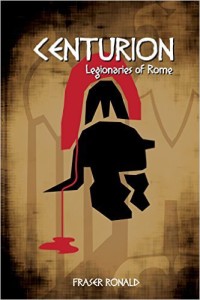
Have you ever wanted to roleplay a Roman centurion in a roleplaying game that takes place during ancient Rome? If so, Centurion: Legionaries of Rome by Fraser Ronald might be just the game you’re looking for.
About two years ago I bought Centurion: Legionaries of Rome. I was going through a “support independent RPGs on Kickstarter and collect Roman RPGs” phase. Thus, I saw Ronald’s proposed work, got excited, and hit the support button. I was not disappointed.

Art and Layout
The Art in Centurion is black and white and illustrated by Kieron O’Gorman. To be honest, the art is not eye-popping candy like so many games are these days. But to be fair, this work was done as an independent RPG and as such, it is pretty good art–I just wish there was more of it in the book. It was the art that actually helped inspire me to pay for the Kickstarter, that and my love for Roman history. Amazingly, there is something about the art that does lure the observer back to the days of centurions and the Roman Empire.
As for the layout, each section of the book is broken down and separated well and in a logical manner. The table of contents is clear and straightforward and there is even some sigil art used to mark chapter changes in the book. But like too many RPG books, there is no index. Which as a GM, I like to have… However, the book is only 168 pages and easy enough to navigate through, thus a boon for any GM wanting to review rules of the game.
Game Mechanics: The Good, the Bad, and the Ugly.
Centurion uses a narrative system which is similar to that of Cortex Plus and Fate. Player characters are made up of a Concept, Traits, and Elements. The number next to each is called a Quality and represents the number of d6 it provides to a die pool. For every 2d6 the character has in a pool he or she can trade it in for a higher die. For example: 2d6 can be 1d8, or 2d8 (which is 4d6) can be traded in for a 1d10. I know… It is slightly confusing, but after some thought and practice the concept becomes simple enough. The dice pool is used to resolve an action in the game with the highest die going first. The goal is to conquer the dice used to oppose (e.g., coming from the environment or another character) your roll. After the dice are tossed and the result is figured out, both the player and the Game Master work together to describe what happened. It can be a beautiful process. However, the mechanics in the game are not as straightforward as other games or even the Fate system. It takes a while to get used to the dice dance used in the system; as a result, the GM may have to read the rules at least two or three times. However, the system does lend to some pretty cool storytelling.
After the rules chapters, Ronald gives advice on how to run a game and create adventures. I won’t give too much away here, but as you probably guessed, his advice is fun and story comes first, rules and historical accuracy come second. He’s a, “let the table of friends tell the story” and not a, “just the GM kind of guy.” Which depending on how you run games,this can be a merit or a drawback for you. Nevertheless, it is only advice and GMs should feel free to run games however they want. As long as the players keep coming, you must be doing something right.
Setting
The setting’s background information ranges from the Late Republic to the Crisis of the Third Century. Centurion does a good job of covering the basics in historical events, including the Civil Wars. I myself prefer the Civil Wars era. A lot is going on during this time, such as internal strife and other intrigues, but regardless of all the events going on, this era is still fairly open-ended which allows for an open sandbox feel. And heck, who wouldn’t want to meet Julius or Augustus?
Ronald’s work also does an excellent job of capturing Roman culture. This includes explaining the Roman class structure and keeping it simple. An added plus to each era covered is some adventure ideas. Again Ronald does an amazing job of painting the image of what each era was like and he succeeds at getting the GM’s imagination going.
Conclusion
Remarkably for a low budget game, Ronald made the book enjoyable to read and not feel like homework. Overall I found the book an asset to my RPG and Roman library. If you’re looking for an RPG to run with little work in creating an adventure, this game is great! It also makes for an enjoyable history lesson.
